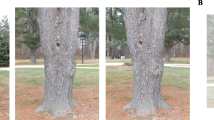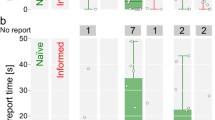Summary
To examine the conditions in which human observers fail to recover the rigid structure of a three-dimensional object in motion we used simulations of discrete helices with various pitches undergoing either pure rotation in depth (rigid stimuli) or rotation plus stretching (non-rigid stimuli). Subjects had either to rate stimuli on a rigidity scale (Experiments 1 and 2) or to judge the amount of rotation of the helices (Experiments 3 and 4). We found that perceived rigidity depended on the pitch of the helix rather than on objective non-rigidity. Furthermore, we found that helices with a large pitch/radius ratio were perceived as highly non-rigid and that their rotation was underestimated. Experiment 5 showed that the detection of a pair of dots rigidly related (located on. the helix) against a background of randomly moving dots is easier at small phases in which the change of orientation across frames is also small. We suggest that this is because at small phases the grouping of dots in virtual lines does occur and that this may be an important factor in the perceived nonrigidity of the helices.
Similar content being viewed by others
References
Adelson, E. H. (1985). Rigid objects that appear highly non-rigid. Investigative Ophthalmology and Visual Science Supplement 26, 56.
Bennett, B. M., & Hoffmann, D. D. (1985). The computation of Structure from Fixed-Axis Motion: Nonrigid Structures. Biological Cybernetics, 51, 293–300.
Bobick, A. (1983). A hybrid approach to structure-from-motion. Proceedings of the ACM Interdisciplinary Workshop on Motion: Representation and Perception, Toronto, Canada, pp. 91–109.
Bouma, H., & Andriessen, J. J. (1968). Perceived orientation of isolated line segments. Vision Research, 8, 493–507.
Braunstein, M. L. (1962). Depth perception in rotation dot patterns: Effects of numerosity and perspective. Journal of Experimental Psychology, 64, 410–420.
Braunstein, M. L., & Andersen, G. J. (1984). A counterexample to the rigidity assumption in the visual perception of structure from motion. Perception, 13, 213–217.
Braunstein, M. L., Hoffman, D. D., & Pollick, F. E. (1990). Discriminating rigid from nonrigid motion: minimum points and views. Perception & Psychophysics, 47, 205–214.
Brown, J. L., & Kortela, I. M. (1977). Orientation discrimination. In S. J. Cool & E. L. Smith (Eds.), Frontiers in visual science (pp. 286–297). New York: Springer-Verlag.
Casco, C., Morgan, J. M., & Ward, R. M. (1989). Spatial properties of mechanisms for detection of moving dot targets in dynamic visual noise. Perception, 18, 285–291.
Clocksin, W. F. (1980). Perception of surface slant and edge labels from optical flow: A computational approach. Perception, 9, 253–269.
Ganis, G., Casco, C., & Roncato, S. (in press). Perceived rigidity and nonrigidity in the Kinetic depth effect. Perception.
Gibson, J. J., & Gibson, E. J. (1957). Continuous perspective transformations and the perception of rigid motion. Journal of Experimental Psychology, 54, 129–138.
Green, B. F. (1961). Figure coherence in the kinetic depth effect. Journal of Experimental Psychology, 62, 272–282.
Green, D. M., & Swets, J. A. (1966). Signal detection theory and psychophysics. New York: Wiley.
Grzywacz, N. M., Hildreth, E. C., Inada, V. K., & Adelsen, E. H. (1988). The temporal integration of 3-D structure from motion: A computational and psychophysical study. In W. Von Seelen, G. Shaw, & U. M. Leinhos, (Eds.), Organization of neural networks (pp. 239–259). Weinheim: VCH.
Grzywacz, N. M., & Hildreth, E. C. (1987). Incremental rigidity scheme for recovering structure from motion: Position-based versus velocity-based formulations. Journal of the Optical Society of America, A4, 503–518.
Grzywacz, N. M., & Yuille, A. (1986). Motion correspondence and analog networks. MIT Artificial Intelligence Memo 888.
Hildreth, E. C. (1984). The measurement of visual motion. ACM Distinguished Dissertation Series. Cambridge, MA: MIT Press.
Hoffman, D. D. (1982). Inferring local surface orientation from motion fields. Journal of the Optical Society of America, 72, 888–892.
Hoffman, D. D., & Bennett, B. N. (1986). The computation of Structure from Fixed-Axis Motion: Rigid Structures. Biological Cybernetics, 54, 71–83.
Hoffman, D. D., & Flinchbaugh, B. E. (1982). The interpretation of biological motion. Biological Cybernetics, 42, 195–204.
Ishiguchi, A. (1988). The effect of orientation on interpolated elastic structure from dot motion. Perception & Psychophysics, 44, 348–357.
Jansson, G., & Johansson, G. (1973). Visual perception of bending motion. Perception, 2, 321–326.
Johansson, G. (1964). Perception of motion and changing form. Scandinavian Journal of Psychology, 5, 181–208.
Johansson, G. (1975). Visual motion perception. Scientific American, 232, 76–88.
Johansson, G. (1977). Spatial constancy and motion in visual perception. In W. Epstein. Stability and constancy in visual perception. New York: Wiley.
Koenderink, J. J., & van Doorn, A. J. (1986). Depth and shape from differential perspective in the presence of bending deformations. Journal of the Optical Society of America, A 3, 242–249.
Longuet-Higgins, H. C. (1981). A computer algorithm for reconstructing a scene from two projections. Nature, 293, 133–135.
Longuet-Higgins, H. C., & Prazdny, K. (1981). The interpretation of moving retinal images. Proceedings of the Royal Society of London, B 208, 385–397.
Marascuilo, L. A. (1970). Extension of the significance test for one-parameter signal detection hypotheses. Psychometrika, 35, 237–243.
Mitiche, A. (1984). Computation of optical flow and rigid motion. Proceedings of the Workshop on Computer Vision: Representation and Control Analysis, Md., pp. 63–71.
Mitiche, A. (1986). On kineopsis and computation of structures and motion. IEEE Transactions in Pattern Analysis and Machine Intelligence. PAMI-8, 109–112.
Mitiche, A., Seida, S., & Aggarwal, J. K. (1985). Determining position and displacement in space from images. Proceedings of the IEEE Conference on Computer Vision and Pattern Recognition, San Francisco, June, pp. 504–509.
Nakayama, K., & Silverman, G. H. (1988). The aperture problem I: Perception of non-rigidity and motion direction in translating sinusoidal lines. Vision Research, 28 (6), 739–746.
Nelson, B. S. (1991). Temporal Interactions in the Cat Visual System. I. Orientation-Selective Suppression in the Visual Cortex. Journal of Neuroscience, 11 (2), 344–356.
Petersick, J. T. (1987). Recovery of structure from motion: Implications for a performance theory based on the structure-from-motion theorem. Perception & Psychophysics, 42, 355–364.
Poggio, T., Torre, V., & Koch, C. (1985). Computational vision and regularization theory. Nature, 317, 314–319.
Prazdny, K. (1980). Egomotion and relative depth map from optical flow. Biological Cybernetics, 36, 87–102.
Prazdny, K. (1983). On the information in optical flows. Computational Vision, Graphics and Image Processing, 22, 239–259.
Proffit, D. R., Gilden D. L., Kaiser M. K., & Whelan S. M. (1988). The effect of configurational orientation on perceived trajectory in apparent motion. Perception & Psychophysics, 43, 315–323.
Sperling, G., Landy, M. S., Dosher, B. A., & Perkins, M. E. (1989). The kinetic depth effect and identification of shape. Journal of Experimental Psychology: Human Perception and Performance, 15, 826–840.
Sperling, G., Pavel, M., Cohen, Y., Landy, M. S., & Schwartz, B. J. (1983). Image processing in perception and cognition. In O. J. Braddick, A. C. Sleigh (Eds.), Physical and biological processing of images. Berlin: Springer-Verlag.
Todd, J. T. (1982). Visual information about rigid and nonrigid motion: A geometric analysis. Journal of Experimental Psychology: Human Perception & Performance, 8, 238–252.
Todd, J. T. (1984). The perception of three-dimensional structure from rigid and nonrigid motion. Perception & Psychophysics, 36, 97–103.
Todd, J. T. (1985). The perception of structure from motion: Is projective correspondence of moving elements a necessary condition? Journal of Experimental Psychology: Human Perception and Performance, 11, 689–710.
Todd, J. T., Akerstrom, R. A., Reichel, F. D., & Hayes, W. (1988). Apparent rotation in three-dimensional space: Effect of temporal, spatial and structural factors. Perception & Psychophysics, 43, 179–188.
Tsai, R. Y., & Huang, T. S. (1981). Uniqueness and estimation of three-dimensional motion parameters of rigid objects with curved surfaces. University of lllinois Urbana-Champaign, Coordinate Science Lab. Report R-921.
Ullman, S. (1979). The interpretation of visual motion. Cambridge, MA: MIT Press.
Ullman, S. (1983). Recent computational studies in the interpretation of structure from motion. In J. Beck, B. Hope, & A. Rosenfeld (Eds.), Human and machine vision. New York: Academic Press.
Ullman, S. (1984). Maximizing rigidity: The incremental recovery of 3-D structure from rigid and nonrigid motion. Perception, 13, 255–274.
Uttal, W. R. (1975). An autocorrelation theory of form detection. Hillsdale, NJ: Lawrence Erlbaum Associates.
Wallach, H., & O'Connell, D. N. (1953). The kinetic depth effect. Journal of Experimental Psychology, 45, 205–217.
Wallach, H., Weisz, A., & Adams, P. A. (1956). Circles and derived figures in rotation. American Journal of Psychology, 45, 205–217.
Waxman, A. M., & Ullman, S. (1985). Surface structure and three-dimensional motion from image flow kinematics. Journal of Robotics Research, 4, 72–94.
White, W. W., & Mueser, G. E. (1960). Accuracy in reconstructing the arrangement of elements generating kinetic depth displays. Journal of Experimental Psychology, 60, 1–11.
Author information
Authors and Affiliations
Additional information
This research was supported by MPI 60% (1987, 1988) and CNR (1986), 1987, 1988) grants to Clara Casco and Sergio Roncato and Grant CNR 90.01603.PS93 to Giorgio Ganis.
Rights and permissions
About this article
Cite this article
Ganis, G., Casco, C. & Roncato, S. Rigid and non-rigid kinetic depth effect with rotating discrete helices. Psychol. Res 55, 1–9 (1993). https://doi.org/10.1007/BF00419887
Received:
Accepted:
Issue Date:
DOI: https://doi.org/10.1007/BF00419887




